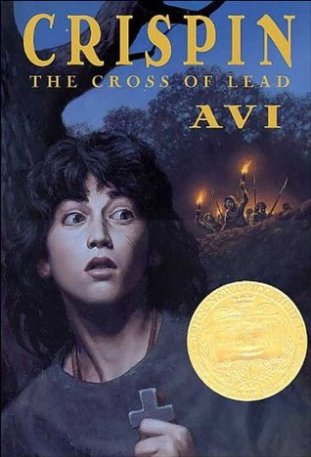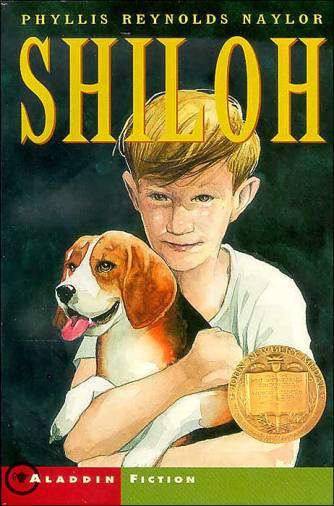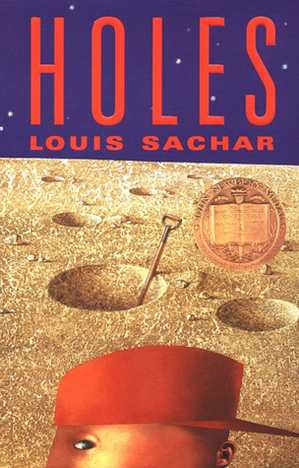
“‘Crispin,’ said Bear, ‘a wise man – he was a jester by trade – once told me that living by answers is a form of death. It’s only questions that keep you living (Avi 2002, p. 111).'”
I apologize for my long absence from this blog, but I’ve been doing a fair amount of ‘fun’ reading, and haven’t found anything quite worthy of reviewing here until now. I had the distinct pleasure of getting to meet Avi at a conference for youth literature recently, and I was quite impressed by both his humor and his sincerity. While speaking of his life and his decision to write for children, Avi shared one of his most famous quotes with the audience: “Writers don’t write writing, they write reading.” Though Avi grew up without knowing he had dysgraphia, he strove constantly to prove to both his teachers and the world that he had ideas worth writing. These ideas later became the inspiration for many children worldwide, compelling him to write over seventy books throughout his lifetime. I found his story to be extremely inspiring, and thus decided to pick up one of his most famous and critically-acclaimed works.
Crispin: The Cross of Lead tells the story of a young boy living in a small, poor English village in the early 1300s. While his life has never been entirely pleasant, the boy (known at the beginning of the novel only as “Asta’s son”) has recently endured the tragic and sudden loss of his mother, catapulting him into a new world of danger and misfortune. Crispin’s only friend, a priest known as Father Quinel, is murdered shortly after the death of the boy’s mother for knowing a terrible secret, one he intended to share with the boy. Before the priest’s death, however, the boy learns that his name is Crispin, and that he must do all in his power to flee the only home he has ever known.
While fleeing his home, however, Crispin is also fleeing the cruel John Aycliffe, a man who has become the steward of the land on which Crispin lives in the absence of Lord Furnival, the land’s true owner. Terrified, Crispin flees with a little bit of food and his only possession, a lead cross given to him by his mother. While on the run, Crispin meets Bear, an odd and interesting red-bearded man who makes his living as a jester. Together, the two embark on a journey that will teach them that the family we choose is sometimes far more important than the family we were assigned at birth.
Though this wouldn’t have been the type of book I would have picked up as a child (I read a lot of fantasy and books about talking animals), I find that I really appreciate it as an adult. Reading stories about history, even fictional ones, is incredibly compelling, making me ponder what it might’ve been like to live in different time periods. While I would’ve liked to see how the story might’ve changed if the main character were female, Crispin’s story was both heart-breaking and incredibly empowering, showing that it’s possible to pull oneself out of even the most terrible of situations and find true joy.
What begins for Crispin as a fight for his life soon leads him to the best thing that has ever happened to him: meeting a true father figure in Bear. At first, Bear seems gruff, cruel, and uncaring; but the reader soon learns that he knows Crispin’s secret and longs to protect the boy from those who would kill him. As they travel, Bear begins teaching Crispin useful skills such as hunting, trapping, and fighting, as well as how to play music and earn a living. When they happen across trouble, Bear protects Crispin, sacrificing himself to keep the boy out of danger.
I’ve always said that characters – and the relationships between those characters – are my favorite part of any story, and this was no exception. Even at his worst, I instantly adored the character of Bear, knowing that his cruel exterior masked a soft and caring interior. Even Avi, when I shared this with him, acknowledged that he thought Bear to be the far more compelling character (despite the book’s title and chosen lead character).
I liked that Bear seemed to represent progress, challenging and criticizing the status quo in the hopes of finding something better. He struck me as being an incredibly brave man, and one who would stop at nothing to make the world a better place – even at the cost of his own life. I think it’s important for children to see that family can encompass many things; it does not have to be defined by biology. As Crispin himself states, Bear is far more of a father to him than the biological father he has never known, and I think that sends a wonderful message about choosing family based on those who love and care for us even when it isn’t required of them.
I was also intrigued by the heavy theme of religion that permeated this novel. While I am a Christian myself, I couldn’t imagine letting my religion dictate my entire life, to the point where I so feared the wrath of my God that I would refuse to break a promise to save my own skin. I can imagine that a modern child reading this story would be highly confused by this time period, as religion today isn’t nearly as life-or-death as it was in England during the 1300s. In fact, children might have trouble reading this novel altogether, as it contains both an extremely advanced vocabulary and several words (such as ‘mazer’), that children have likely never come across before. This is definitely a title I would recommend for either advanced readers or those reading far above their grade level who would like a challenge.
Despite the difficulty of the text, however, I think children would be fascinated to see how different life was during this time, and how hard many people had to work just to survive. A child already facing poverty might understand (at least to some extent) Crispin’s struggles, but a child who was born into wealth might find this novel to be an excellent window into the struggles of others. This novel would be of excellent use in a history class, as the teacher could explain that this time period was incredibly difficult for many people, who lived both in poverty and constant fear of deadly illnesses like the Plague. Stories like Crispin’s have the power to teach both empathy and understanding, alerting children to the privileges that come with growing up in the United States in the present day.
Though it was short and simple, this story was powerful, and I could easily see why it earned a Newbery Medal. It takes place far from our own time, but the lessons Crispin learns are universal. He learns both to defend and stand up for himself, while also learning how to survive in an incredibly cruel and unforgiving world. He transforms from a passive character, afraid of his own shadow, to someone willing to fight for the people he cares most about. This shows children that they have an innate power to change their lives, and that they don’t have to resign themselves to simply living with injustice or cruelty. As mentioned above, Crispin also teaches children the true meaning of family, and that the strongest bonds are sometimes forged when we are at our lowest points.
I felt incredibly honored to have met Avi, and I hope to read more of his work in the near future. Reading Crispin, I had a hard time believing that the author suffers from a learning disability; his writing is detailed, emotional, and incredibly well-structured. Avi, much like the character of Crispin, is proof that (with a little effort and determination) anyone can pull themselves out of a terrible situation and turn it into a lesson or an inspiration, and I think any child in need of such a lesson could greatly benefit from reading this book.
Reference:
Avi. (2002). Crispin: Cross of Lead. New York: Hyperion Books for Children.

